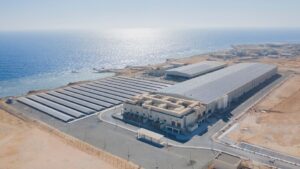The clock is ticking for electro-intensive industries to meet their greenhouse gas reduction targets – both internal and external. That’s because major changes can’t happen overnight, the path to decarbonization involves a long-term strategy. For example, companies’ internal emissions reduction commitments often include goals like net-zero emissions by 2050. Achieving these will only be possible if industrial energy users act now to meet near-term targets.
Why is heavy industry under pressure to decarbonize?
Two reasons:
- Electro-intensive industries have a massive carbon footprint. According to the IEA, direct industrial CO2 emissions are responsible for 26 percent of total global emissions, roughly 8.7 GT CO2/year. Industries like steel, cement, and chemicals are responsible for the bulk of these emissions.
- Heavy industry is not currently taking all opportunities to decarbonize processes: 78% of the industrial sector’s energy demand is not electrified. This means that a majority of industrial processes’ equipment, like pumps and motors, are unnecessarily being powered by fossil fuels.

Process electrification reduces the carbon footprint of industrial energy users
One of the key reasons process electrification is essential to heavy industries’ green strategy is because the potential impact is huge. That’s because electricity is the best vector for decarbonization, slashing direct CO2 emissions at end use.
Plus, process electrification is already a proven way to reduce industries’ carbon footprint without sacrificing production or performance. In addition, while there can be technological challenges in moving from combustion-based systems to electrical ones, 50 percent of site energy can be electrified today using existing technology, so industries don’t need to postpone their battle with climate change.
Which industrial processes can be electrified?
Process electrification is a way to drive a wide range of industrial and manufacturing processes by using electricity rather than fossil fuel combustion. The two main categories of process electrification are:
- Process heating: This is the heat that powers manufacturing, such as furnaces, steam boilers, and gas-fired heaters. Process heating can be electrified. For example, in the steel industry traditional blast furnaces/basic oxygen furnaces can be replaced by electric arc furnaces.
- Motion/machine drive: This category is related to powering equipment like compressors and pumps. For example, in the oil and gas industry, this can involve replacing turbines/engines by electric motors in compressor packages (i.e;, export, injection, liquefaction, etc.), among other solutions.
The rewards of process electrification go beyond decarbonization
Research shows that process electrification for industrial companies is not only good at reducing greenhouse gas emissions. There are other compelling reasons to electrify industrial processes:
- Counteract new threats to business continuity: With major uncertainty related to the availability and cost of fossil fuel sources, green electrification and on-site microgrid can help mitigate production shutdown risks.
- Improved energy efficiency of electrified process: Electrifying processes is almost always more energy efficient than using fossil fuels. For example, drying methods are responsible for an estimated 10 to 25 percent of industrial energy consumption. Using heat pumps could bring an up to 80 percent energy savings and an 80 percent decrease in carbon emissions compared to conventional natural gas burners.
- Better control, driving higher efficiency: Industrial equipment has a long lifespan, often lasting decades. Making the switch from fossil fuels to electrification is also an opportunity to upgrade equipment’s technology and components to ensure it is performing at maximum efficiency (e.g., load sharing, central energy management system).
- Lower maintenance costs: Maintenance costs for electric and hybrid industrial machines are often lower because component life is longer and there is less wear and tear.
Enablement of remote operations: Process electrification depends on digital technology, such as sensors and control mechanisms, which can uncover new opportunities for remote operations.
- Participation in grid flexibility mechanisms: Increasing electrification creates new loads on the power system, but can also help balance electricity grids by offering flexibility to grid operators. It can bring grid flexibility through demand-side management using energy efficiency and demand response.
One Brazilian FPSO reduced its emissions by 100k tCO2e/year through process electrification
Let’s take a look at how process electrification is already being used. By electrifying its processes, a Brazilian floating production storage and offloading (FPSO) business was able to reduce around 100k tCO2e/year by redesigning the process – switching from gas turbine compressors and gas engine water pumps to electrical driven packages.
The load of the plant was initially estimated to increase from 80MW to 150MW due to the additional electrical equipment. But by leveraging Schneider Electric’s electrical, digital, and control expertise alongside its engineering software tools, the customer optimized the overall architecture and reduced the load from 150MW to 110MW.
Overall, the customer was able to reduce the number of turbines, which let them achieve CO2 reduction, CapEx and OpEx savings, and a much higher level of efficiency, availability, and reliability of the entire system.
Industrial decarbonization is easier with the right guide
Schneider Electric’s holistic know-how and end-to-end deployment brings peace-of-mind for the new reality. By working with us, you’ll benefit from expertise and execution from the same trusted partner. We have worked on electricity management with customers across industries so we deeply understand the domains and appreciate the unique complexities of electrifying processes – from design, execution and commissioning to maintenance and modernization.
Learn how to kick off your process electrification strategy
Read our handout to learn more about how process electrification can transform your operations and help you meet climate goals. You can also schedule an exploratory meeting with our experts so that we can understand your needs and guide you on meeting your goals.



